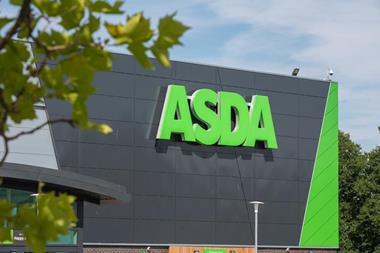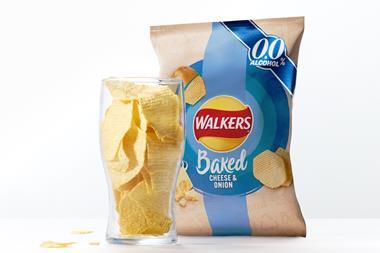Asda’s performance over the past year has been less than inspiring. Can it turn things around? Rachel Barnes reports
Next week, Jay Fitzsimmons, Wal-Mart’s senior vice president for finance, arrives in London to show Asda boss Andy Bond a bit of much needed moral support as they talk to analysts about Asda’s recent performance and outline the chain’s game plan for taking on Tesco in 2006.
No doubt one of the things the audience will be keen to chat about will be the launch of Asda’s new ‘Discount Plus’ format revealed exclusively in The Grocer this week. The move, which pitches the retailer against the hard discounters, as well as giving it another way of fighting back against the UK’s number one retailer, certainly shows balls - and is a sign that Asda is ready to pursue a genuinely multi-format strategy. It is also an inspired alternative to the convenience route. But is it too little too late?
The multiple has a lot of ground to make up. It totally failed to read the planning regime in the 1990s, sticking to a big box format despite tighter planning rules, a lack of development sites across the country and a simultaneous shift by its main rivals into smaller stores and convenience.
Although two years ago it took over Sainsbury as the number two supermarket and there were even headlines suggesting it had Tesco in its sights, it wasn’t long before the proverbial chickens came home to roost.
First, the City got the bit between its teeth over a succession of less than sparkling performance statements. Then came the hammer blow of 1,400 redundancies.
It doesn’t take more than a cursory look at the graph on the right to see just how far below the industry average Asda’s sales growth has been for much of the past year.
More to the point, its figures have been drifting ever further behind Tesco’s, with market share not expected to improve in the short term.
Asda’s annual results for 2004, which were released in October, paint a decent enough picture: turnover in its retail business rose 7.2% to £14.2bn and operating profit rose 5% to £670.3m - even though group pre-tax profit, which includes its property business, slipped 5% to £638.8m.
But fast forward to a Wal-Mart results presentation in November and things seem to take a turn for the worse. Mike Duke, head of international operations, describes Asda’s comparable store sales and market share as “essentially flat”. In the third quarter, after petrol sales are stripped out, total sales at Asda grew in the low single digits.
Duke tells investors: “Asda sales and profits fell short of plan for the quarter; the UK market continues to be very competitive and challenging.”
Most analysts agree this has been Asda’s worst year since the Wal-Mart takeover. Justin Scarborough, an analyst at Panmure Gordon, says: “Andy Bond has been given a mission to reinvigorate the business, so clearly there’s been a problem. If you look at market share data and like-for-likes, in the context of the past five to 10 years, it’s not been a great year.”
The clouds have occasionally had a silver lining. Bond is adamant that Asda will retain its crown as the UK’s cheapest supermarket. And looking back over the past 26 weeks, the retailer has been named as the cheapest in The Grocer 33 for an unbeatable17 times, compared with Tesco and Sainsbury, each claiming the top honour four times.
But it’s getting harder to maintain the lead, says Panmure’s Scarborough, in the wake of greater price investment from Morrisons lowering prices across Safeway stores, Sainsbury’s tighter pricing and Tesco “carrying on doing what it’s doing”.
There’s another worry: despite its track record on price, Asda has only won the Top Store award once in The Grocer 33 survey. Poor customer service, long queues, inattentive checkout staff and availability problems have dogged Asda’s performance.
So is Bond the man to turn things around? As we report over the page, many inside the business think he is. But one former Asda director, who was part of the recovery team led by Archie Norman in the 1990s, is worried about the lack of new blood within the business. He says: “Not many people really left immediately after Wal-Mart. We were all tied in with bonuses - some 70% of salaries. It was an easier life as we were suddenly out of the limelight from the City’s point of view. Wal-Mart wanted to retain the senior team so wasn’t squeezing too hard.
“But the cut and thrust people moved on. And the people leading the company today, such as Bond, reported in to us. They are divisional directors that have risen up, but with no real strategic external boardroom experience, which is what Asda needs now.”
Asda is addressing the management issue. Last week, it revealed it had poached two senior Tesco executives: commercial director for Thailand Darren Blackhurst, who is now Asda’s new food trading director, and operations director Stuart Machin, who takes on the new central operations director role (The Grocer, December 3, p18). This year, it also brought back two former Asda talents in the shape of David Cheesewright as COO and Andy Clarke as retail director.
The new-look team’s immediate priority is getting Asda’s growth strategy back on track. But how? Its strength in non food will clearly help, particularly in the run-up to the key Christmas trading period - and the Asda team will be updating analysts on its plans in that area next week.
Verdict Research analyst Gavin Rothwell says it will have a tougher fight on its hands this year: “Sainsbury is far better equipped in both food and non food this Christmas. It will put up formidable opposition, which means Asda will have to work a bit harder.”
He also believes Asda has taken its eye off the ball when it comes to developing its food ranges. “It’s lost some ground on its rivals in this area, especially at the upper end. Asda needs to remember that food is the key footfall driver at the end of the day, no matter how good it is in non food.”
Another analyst says: “They’ve got people going into stores, their basket size is pretty good and they can’t become much more competitive on price as it would impact margins. So it must now either grow the basket size or start opening up more space, preferably both.”
If new space is the key, then Asda’s recent deal in Northern Ireland will help on that front. The same could be true of the chain’s new store format - which also demonstrates its confidence in its own-label range.
The chain’s finance director, Judith McKenna, says: “It’s a completely new proposition that is building on the quality credentials of Asda’s brand. Something like this is really on people’s doorsteps and we think it’s going to provide access to markets we’ve not currently got.”
McKenna also acknowledges that it should be easier to secure planning consent for the new format stores. She says: “There’s no doubt that trying to get an 8,000 sq ft store through planning is easier than 110,000 sq ft superstores. I don’t think there’s an easy way through the planning regime, but what this means is that it opens up more of the market to us. We are really excited about it.”
So, will the new format satisfy the critics? Probably not. But it shows how far Asda is willing to go in the search for growth.
Timeline: key developments in Asda’s rollercoaster year
March 11 - Tony DeNunzio announces he is quitting as president and will leave within weeks to join Dutch retailer Vendex KBB.
March 18 - Andy Bond steps up from Asda chief operating office to become president of the chain.
July 5 - Bond announces that 1,400 people will be made redundant - 200 from head office and 1,200 in-store junior management positions - after the retailer has not performed to Wal-Mart’s plan. Bond vows to protect Asda’s position as “the lowest-priced retailer in the UK”.
July 27 - Asda workers from its Washington depot go out on a three-day strike over pay.
October 22 - Bond blasts the industry for developing a “bland, amorphous sameness” in terms of product and stores that is turning off shoppers. October 27 - Asda Group publishes 2004 results. Retail turnover is up 7.2% to £14.2bn and operating profit up 5% to £670.3m. But group pre-tax profit slipped 5% to £638.3m.
November 14 - Wal-Mart head of global operations Mike Duke says Asda’s third-quarter performance in 2005 is “essentially flat”.
December 10 - Reveals plans for new small store format called Discount Plus.
Next week, Jay Fitzsimmons, Wal-Mart’s senior vice president for finance, arrives in London to show Asda boss Andy Bond a bit of much needed moral support as they talk to analysts about Asda’s recent performance and outline the chain’s game plan for taking on Tesco in 2006.
No doubt one of the things the audience will be keen to chat about will be the launch of Asda’s new ‘Discount Plus’ format revealed exclusively in The Grocer this week. The move, which pitches the retailer against the hard discounters, as well as giving it another way of fighting back against the UK’s number one retailer, certainly shows balls - and is a sign that Asda is ready to pursue a genuinely multi-format strategy. It is also an inspired alternative to the convenience route. But is it too little too late?
The multiple has a lot of ground to make up. It totally failed to read the planning regime in the 1990s, sticking to a big box format despite tighter planning rules, a lack of development sites across the country and a simultaneous shift by its main rivals into smaller stores and convenience.
Although two years ago it took over Sainsbury as the number two supermarket and there were even headlines suggesting it had Tesco in its sights, it wasn’t long before the proverbial chickens came home to roost.
First, the City got the bit between its teeth over a succession of less than sparkling performance statements. Then came the hammer blow of 1,400 redundancies.
It doesn’t take more than a cursory look at the graph on the right to see just how far below the industry average Asda’s sales growth has been for much of the past year.
More to the point, its figures have been drifting ever further behind Tesco’s, with market share not expected to improve in the short term.
Asda’s annual results for 2004, which were released in October, paint a decent enough picture: turnover in its retail business rose 7.2% to £14.2bn and operating profit rose 5% to £670.3m - even though group pre-tax profit, which includes its property business, slipped 5% to £638.8m.
But fast forward to a Wal-Mart results presentation in November and things seem to take a turn for the worse. Mike Duke, head of international operations, describes Asda’s comparable store sales and market share as “essentially flat”. In the third quarter, after petrol sales are stripped out, total sales at Asda grew in the low single digits.
Duke tells investors: “Asda sales and profits fell short of plan for the quarter; the UK market continues to be very competitive and challenging.”
Most analysts agree this has been Asda’s worst year since the Wal-Mart takeover. Justin Scarborough, an analyst at Panmure Gordon, says: “Andy Bond has been given a mission to reinvigorate the business, so clearly there’s been a problem. If you look at market share data and like-for-likes, in the context of the past five to 10 years, it’s not been a great year.”
The clouds have occasionally had a silver lining. Bond is adamant that Asda will retain its crown as the UK’s cheapest supermarket. And looking back over the past 26 weeks, the retailer has been named as the cheapest in The Grocer 33 for an unbeatable17 times, compared with Tesco and Sainsbury, each claiming the top honour four times.
But it’s getting harder to maintain the lead, says Panmure’s Scarborough, in the wake of greater price investment from Morrisons lowering prices across Safeway stores, Sainsbury’s tighter pricing and Tesco “carrying on doing what it’s doing”.
There’s another worry: despite its track record on price, Asda has only won the Top Store award once in The Grocer 33 survey. Poor customer service, long queues, inattentive checkout staff and availability problems have dogged Asda’s performance.
So is Bond the man to turn things around? As we report over the page, many inside the business think he is. But one former Asda director, who was part of the recovery team led by Archie Norman in the 1990s, is worried about the lack of new blood within the business. He says: “Not many people really left immediately after Wal-Mart. We were all tied in with bonuses - some 70% of salaries. It was an easier life as we were suddenly out of the limelight from the City’s point of view. Wal-Mart wanted to retain the senior team so wasn’t squeezing too hard.
“But the cut and thrust people moved on. And the people leading the company today, such as Bond, reported in to us. They are divisional directors that have risen up, but with no real strategic external boardroom experience, which is what Asda needs now.”
Asda is addressing the management issue. Last week, it revealed it had poached two senior Tesco executives: commercial director for Thailand Darren Blackhurst, who is now Asda’s new food trading director, and operations director Stuart Machin, who takes on the new central operations director role (The Grocer, December 3, p18). This year, it also brought back two former Asda talents in the shape of David Cheesewright as COO and Andy Clarke as retail director.
The new-look team’s immediate priority is getting Asda’s growth strategy back on track. But how? Its strength in non food will clearly help, particularly in the run-up to the key Christmas trading period - and the Asda team will be updating analysts on its plans in that area next week.
Verdict Research analyst Gavin Rothwell says it will have a tougher fight on its hands this year: “Sainsbury is far better equipped in both food and non food this Christmas. It will put up formidable opposition, which means Asda will have to work a bit harder.”
He also believes Asda has taken its eye off the ball when it comes to developing its food ranges. “It’s lost some ground on its rivals in this area, especially at the upper end. Asda needs to remember that food is the key footfall driver at the end of the day, no matter how good it is in non food.”
Another analyst says: “They’ve got people going into stores, their basket size is pretty good and they can’t become much more competitive on price as it would impact margins. So it must now either grow the basket size or start opening up more space, preferably both.”
If new space is the key, then Asda’s recent deal in Northern Ireland will help on that front. The same could be true of the chain’s new store format - which also demonstrates its confidence in its own-label range.
The chain’s finance director, Judith McKenna, says: “It’s a completely new proposition that is building on the quality credentials of Asda’s brand. Something like this is really on people’s doorsteps and we think it’s going to provide access to markets we’ve not currently got.”
McKenna also acknowledges that it should be easier to secure planning consent for the new format stores. She says: “There’s no doubt that trying to get an 8,000 sq ft store through planning is easier than 110,000 sq ft superstores. I don’t think there’s an easy way through the planning regime, but what this means is that it opens up more of the market to us. We are really excited about it.”
So, will the new format satisfy the critics? Probably not. But it shows how far Asda is willing to go in the search for growth.
Timeline: key developments in Asda’s rollercoaster year
March 11 - Tony DeNunzio announces he is quitting as president and will leave within weeks to join Dutch retailer Vendex KBB.
March 18 - Andy Bond steps up from Asda chief operating office to become president of the chain.
July 5 - Bond announces that 1,400 people will be made redundant - 200 from head office and 1,200 in-store junior management positions - after the retailer has not performed to Wal-Mart’s plan. Bond vows to protect Asda’s position as “the lowest-priced retailer in the UK”.
July 27 - Asda workers from its Washington depot go out on a three-day strike over pay.
October 22 - Bond blasts the industry for developing a “bland, amorphous sameness” in terms of product and stores that is turning off shoppers. October 27 - Asda Group publishes 2004 results. Retail turnover is up 7.2% to £14.2bn and operating profit up 5% to £670.3m. But group pre-tax profit slipped 5% to £638.3m.
November 14 - Wal-Mart head of global operations Mike Duke says Asda’s third-quarter performance in 2005 is “essentially flat”.
December 10 - Reveals plans for new small store format called Discount Plus.



















No comments yet